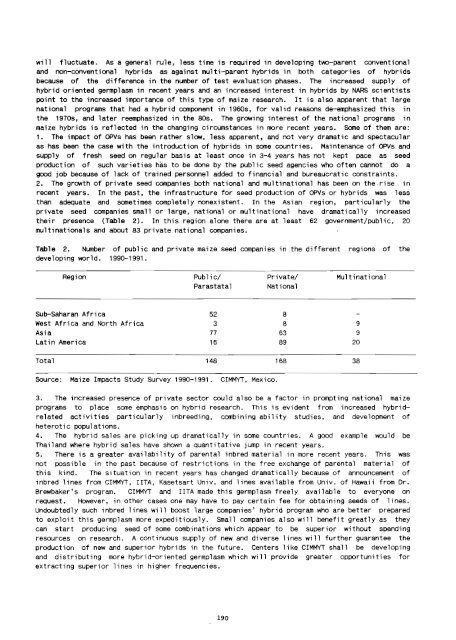Proceedings of the Fifth Asian Regional Maize Workshop - Search ...
Proceedings of the Fifth Asian Regional Maize Workshop - Search ...
Proceedings of the Fifth Asian Regional Maize Workshop - Search ...
You also want an ePaper? Increase the reach of your titles
YUMPU automatically turns print PDFs into web optimized ePapers that Google loves.
will fluctuate. As a general rule, less time is required in developing two-parent conventional<br />
and non-conventional hybrids as against multi-parent hybrids in both categories <strong>of</strong> hybrids<br />
because <strong>of</strong> <strong>the</strong> difference in <strong>the</strong> number <strong>of</strong> test evaluation phases. The increased supply <strong>of</strong><br />
hybrid oriented germplasm in recent years and an increased interest in hybrids by NARS scientists<br />
point to <strong>the</strong> increased importance <strong>of</strong> this type <strong>of</strong> maize research. It is also apparent that large<br />
national programs that had a hybrid component in 1960s, for valid reasons de-emphasized this in<br />
<strong>the</strong> 1970s, and later reemphasized in <strong>the</strong> 80s. The growing interest <strong>of</strong> <strong>the</strong> national programs in<br />
maize hybrids is reflected in <strong>the</strong> changing circumstances in more recent years. Some <strong>of</strong> <strong>the</strong>m are:<br />
1. The impact <strong>of</strong> OPVs has been ra<strong>the</strong>r slow, less apparent, and not very dramatic and spectacular<br />
as has been <strong>the</strong> case with <strong>the</strong> introduction <strong>of</strong> hybrids in some countries. Maintenance <strong>of</strong> OPVs and<br />
supply <strong>of</strong> fresh seed on regular basis at least once in 3-4 years has not kept pace as seed<br />
production <strong>of</strong> such varieties has to be done by <strong>the</strong> public seed agencies who <strong>of</strong>ten cannot do a<br />
good job because <strong>of</strong> lack <strong>of</strong> trained personnel added to financial and bureaucratic constraints.<br />
2. The growth <strong>of</strong> private seed companies both national and multinational has been on <strong>the</strong>,rise in<br />
recent years. In <strong>the</strong> past, <strong>the</strong> infrastructure for seed production <strong>of</strong> OPVs or hybrids was less<br />
than adequate and sometimes completely nonexistent. In <strong>the</strong> <strong>Asian</strong> region, particularly <strong>the</strong><br />
private seed companies small or large, national or multinational have dramatically increased<br />
<strong>the</strong>ir presence (Table 2). In this region alone <strong>the</strong>re are at least 62 government/public, 20<br />
multinationals and about 83 private national companies.<br />
Table 2. Number <strong>of</strong> public and private maize seed companies in <strong>the</strong> different regions <strong>of</strong> <strong>the</strong><br />
developing world. 1990-1991.<br />
Region<br />
Publici<br />
Parastatal<br />
Private/<br />
National<br />
Multinational<br />
Sub-Saharan Africa<br />
West Africa and North Africa<br />
Asia<br />
Latin America<br />
Total<br />
52 8<br />
3 8<br />
77 63<br />
16 89<br />
148 168<br />
9<br />
9<br />
20<br />
38<br />
Source: <strong>Maize</strong> Impacts Study Survey 1990-1991. CIMMYT, Mexico.<br />
3. The increased presence <strong>of</strong> private sector could also be a factor in prompting national maize<br />
programs to place some emphasis on hybrid research. This is evident from increased hybridrelated<br />
activities particularly inbreeding, combining ability studies, and development <strong>of</strong><br />
heterotic populations.<br />
4. The hybrid sales are picking up dramatically in some countries. A good example would be<br />
Thailand where hybrid sales have shown a quantitative jump in recent years.<br />
5. There is a greater availability <strong>of</strong> parental inbred material in more recent years. This was<br />
not possible in <strong>the</strong> past because <strong>of</strong> restrictions in <strong>the</strong> free exchange <strong>of</strong> parental material <strong>of</strong><br />
this kind. The situation in recent years has changed dramatically because <strong>of</strong> announcement <strong>of</strong><br />
inbred lines from CIMMYT, IITA, Kasetsart Univ. and lines available from Univ. <strong>of</strong> Hawaii from Dr.<br />
Brewbaker's program. CIMMYT and IITA made this germplasm freely available to everyone on<br />
request. However, in o<strong>the</strong>r cases one may have to pay certain fee for obtaining seeds <strong>of</strong> lines.<br />
Undoubtedly such inbred lines will boost large companies' hybrid program who are better prepared<br />
to exploit this germplasm more expeditiously. Small companies also will benefit greatly as <strong>the</strong>y<br />
can start producing seed <strong>of</strong> some combinations which appear to be superior without spending<br />
resources on research. A continuous supply <strong>of</strong> new and diverse lines will fur<strong>the</strong>r guarantee <strong>the</strong><br />
production <strong>of</strong> new and superior hybrids in <strong>the</strong> future. Centers like CIMMYT shall be developing<br />
and distributing more hybrid-oriented germplasm which will provide greater opportunities for<br />
extracting superior lines in higher frequencies.<br />
190

















